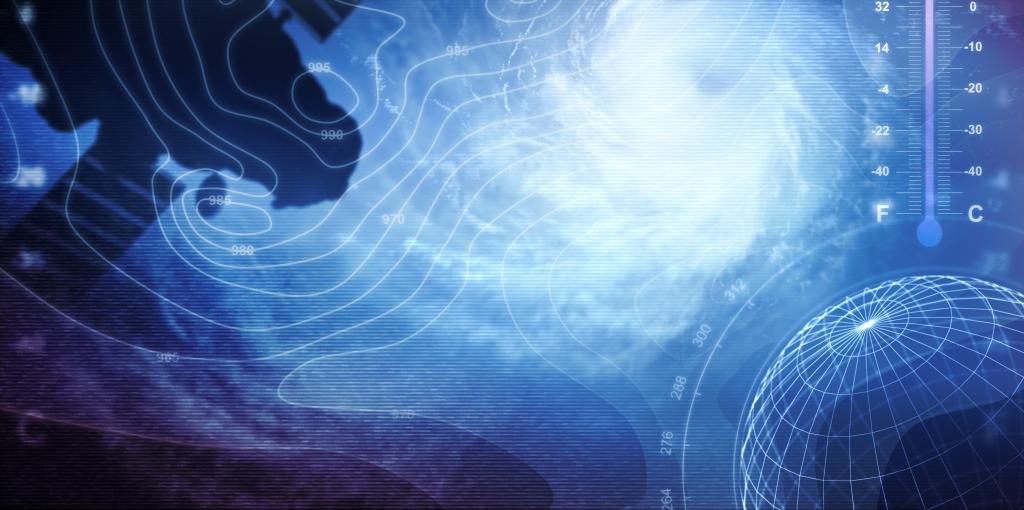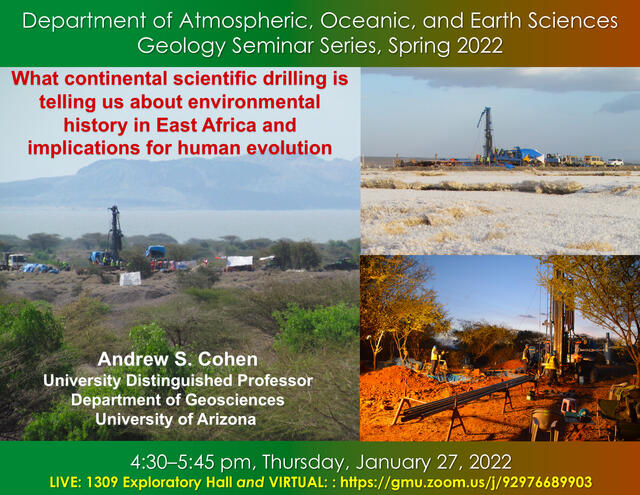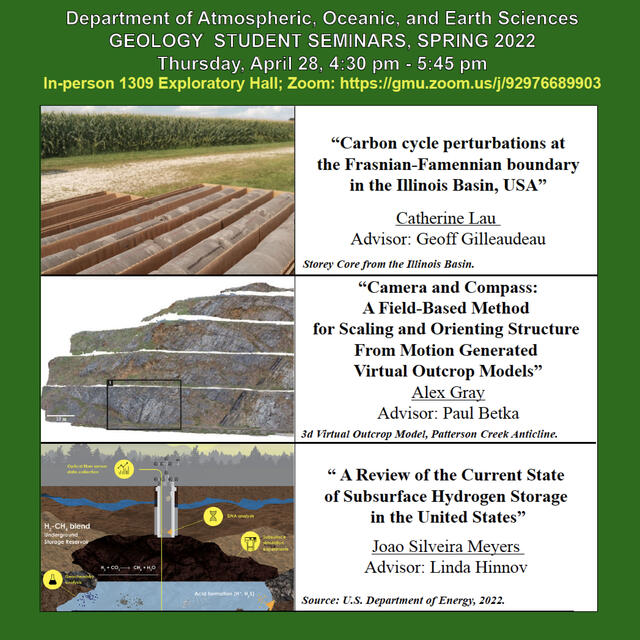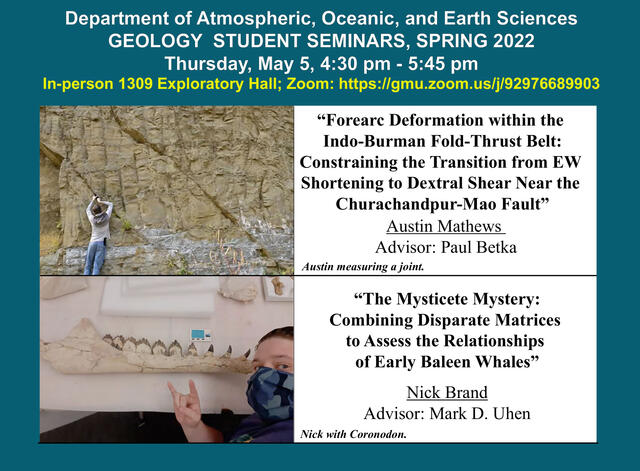2021-2022 Seminars
Admission CTAs
Main navigation
Section Navigation: AOES Seminars
Graduate Symposium
2026 Earth System Observations and Modeling Graduate Symposium, April 10th. Accepting Abstracts.

Summer 2022 AOES Seminars
13 Jul (CLIM) Campbell, MS Defense, Tropical Cyclone Variability
Jacob Campbell, Climate Science Masters Program
Understanding the Impact of the Madden-Julian Oscillation and the North Atlantic Subtropical High on Atlantic Tropical Cyclone variability
Wed, 13 Jul, 1:30pm, Johnson Center room G and via zoom (contact bklinger@gmu.edu for link)
Thesis Director: Dr. David Straus
Tropical cyclone (TC) frequencies in the Atlantic Ocean have multiple sources of variability. Two important ones are the Madden-Julian Oscillation (MJO) and North Atlantic Subtropical High (NASH). A detailed analysis into the combined effects of these together could be helpful in determining higher or lower TC frequencies in the Atlantic subregions – Caribbean, Gulf of Mexico, etc. – and the Atlantic as a whole. An established relationship could also be beneficial for forecasting TCs on a subseasonal timescale. This investigation identifies combinations of this co-relationship utilizing contingency tables and chi-square independence analysis. It is shown there is a possible relationship between MJO and NASH where certain MJO phases modulate the NASH’s location and explain some TC frequency patterns. For the Gulf of Mexico, a combination of MJO phases 1-4 and a western NASH extension resulted in much higher TC counts. For the North American east coast, MJO phases 1 through 4 and a northwest NASH extension resulted in the most TCs. Vertical wind shear values related to MJO phases and observed NASH locations support these findings.
18 Jul (GEOL) Mathews, MS Defense, Forearc Deformation
Austin Mathews, Earth Systems Science Master's Program
Forearc Deformation Within the Indo-Burman Fold-Thrust Belt: Constraining the Transition from Plane Strain Shortening to Noncoaxial Dextral Transpression Near the Churachandpur-Mao Fault
Mon, 18 Jul, 1:30pm, Exploratory Hall 1309
Thesis Director: Paul Betka
Subduction margins around the world are known to produce some of the largest and deadliest earthquakes. Megathrust earthquakes have been documented to occur even when plate convergence is highly oblique. Obliquely convergent margins commonly accommodate convergence through the development of forearc fault systems which separately accommodate components of margin-normal and margin-parallel convergence. The partitioning among forearc fault systems influences the structural evolution and patterns of seismicity at oblique convergent margins. This study capitalizes on the subaerial exposure of the Indo-Burman Ranges, an accretionary wedge resulting from the oblique (70°) collision of India and Eurasia, to characterize faults and folds that accommodate oblique convergence. This study utilizes field datasets, cross section construction, structural analyses of faults and folds, and kinematic modeling to constrain the transition from west-directed shortening in the Outer Belt to dextral shear near the Churachandpur-Mao Fault. Results indicate that structures in the Outer Belt are experiencing NNW-SSE directed plane strain and accommodating margin-normal shortening as fault-propagation folds. These Outer Belt structures have accommodated 24.9 km of shortening and are forming above a folded décollement which ranges in depth (3.0 – 5.6 km), deepening westward in the transport direction of the accretionary wedge due to flexural subsidence in the Sylhet Basin. Near the Churachandpur-Mao Fault, transpressional fault splays strike northwest and modify structures from the fold-thrust belt in a 20 km wide distributed zone of transpressional deformation. East of the CMF, the transpressional zone of deformation intensifies and forms a pervasive sub-vertical cleavage fabric with prominent isoclinal folding in the Axial Zone. Field evidence for the transpressional deformation in the core of the IBR accretionary wedge spans to the Kabaw Fault. Structural and geodetic modeling suggests the Kabaw Fault includes a crustal-scale structure and is a dextral-oblique thrust. Together, the CMF and Kabaw Fault are undergoing distributed transpressional strain that manifests in a contractional left stepover between the two right-lateral faults, forming a positive flower structure in the core of the IBR. Altogether, results indicate the IBR are a product of ongoing oblique subduction and are partitioned into the Outer Belt which accommodates margin-normal convergence, and the Inner Belt/Axial Zone which primarily accommodates margin-parallel convergence in a zone of distributed, dextral and transpressional shear. If the subduction interface is locked and accumulating strain as recent geodetic studies suggest, then there is the potential for a large-magnitude earthquake in the region.
Spring 2022 AOES Seminars
27 Jan (GEOL) Cohen, Paleolimnology of Africa
1 Feb (CLIM) Davenport, Climate Impact Process Understanding
Frances Davenport, Stanford U
Tue, 1 Feb, 11:30-12:30, Research Hall rm 163
Historical and Future Climate Impacts: From quantitative approaches to process understanding
Extreme climate events like severe precipitation, extreme heat, drought, and wildfires, have a disproportionate impact on society and ecosystems, but are challenging to model and predict due to their complexity and rarity. As a result, there are many unresolved questions about the characteristics of extreme events in a changing climate. In this talk, I will highlight examples from my research to understand climate extremes and their impacts. First, I will present research using quantitative, causal inference methods to understand the economic and societal impacts of climate extremes, illustrating an example of precipitation and flooding in the U.S. I find that more than one third of recent U.S. flood damages are due to historical changes in precipitation. I also analyze precipitation change simulated in an ensemble of global climate models and find that the pattern of observed change is consistent with human-caused climate change. In the second part of the talk, I will present research to understand the physical processes leading to changes in extreme precipitation and flooding. One effect of global warming is that warmer winter temperatures cause a shift from winter snow to winter rain. Using causal inference regression techniques to analyze data from over 400 watersheds in the western U.S., I show that this shift from snow to rain leads to non-linear increases in flood size due to larger rain-driven floods compared to snowmelt. Additionally, I use deep learning to understand the processes that lead to increases in extreme precipitation occurrence. Using the U.S. Midwest region as a case study, I find that large-scale atmospheric circulation conditions associated with extreme precipitation have become more frequent over the past 20 years. These increases in frequency have co-occurred with increases in atmospheric moisture flux to the Midwest region. As a result, these conditions are also more likely to result in extreme precipitation now than in the past. Combined, this research (i) provides new empirical evidence quantifying the impacts of climate change, which can inform policy decisions and climate adaptation, and (ii) demonstrates new methodological approaches to develop process-based understanding of climate extremes that can be extended broadly to study other hazards and regions.
3 Feb (GEOL) Tortarolo, Seismic Stratigraphy of Amazon Fan
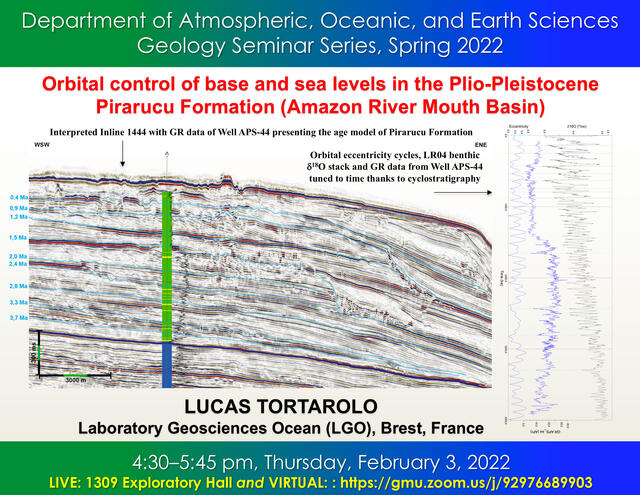
Lucas Tortarolo, University of Brest, Seismic stratigraphy of Amazon Fan
3 Feb (CLIM) Hoell, Predictability Research, Climate Services
Andrew Hoell, NOAA PSL
Thu, 3 Feb, 10:00-11:00, Research Hall rm 163
Earth System Predictability Research and Assessments to Support Climate Services
Extreme weather and climate events in 2021 led to 280 billion U.S. dollars in economic losses globally1 and contributed to the emergency food assistance needs of 97 million people in sub-Saharan Africa, Central America, and Southwest Asia2. I will detail how Climate Services informed by Earth system predictability research and assessments can provide early warning of future environmental extremes in Afghanistan and North America, thereby preparing vulnerable populations with limited capacity to cope. In Afghanistan, I will describe the forward-looking food security scenario development process used by the Famine Early Warning Systems Network, and illustrate how scenarios in 2021-2022 were guided by physically-based predictability research of environmental conditions relevant to agriculture. In North America, I will describe assessments of recent droughts in the U.S. Great Plains and Southwest that each led to billions of dollars in economic losses, and how they were used to inform planning and adaptation for future droughts. I will finish with considerations for the future of Climate Services, including spatial scales for predictions and predictability research, and engaging stakeholders.
8 Feb (CLIM) Ortiz, Climate Change and the Built Environment
Luiz Ortiz, US Department of Transportation
Tue, 8 Feb, 9:00-10:00, via zoom (contact bklinger@gmu.edu for link)
Climate change and the built environment: Interactions, impacts, and adaptation strategies
With temperatures rising in cities worldwide and the majority of humans now living in urban centers, quantifying urban climate processes has become increasingly important. Cities interact with their environment by fundamentally altering the surface energy balance while limiting natural cooling processes (e.g., soil moisture evaporation). These processes, in general, lead to higher temperatures in cities compared to surrounding suburban and rural areas, a phenomenon called the urban heat island (UHI). In this talk, Dr. Ortiz will present a brief overview of urban-atmosphere interactions and their implications to overall climate in cities. Then, he will focus on the most common heat adaptation strategy, air conditioning, as an important linkage between human activity and the atmosphere. Using New York City as a case study, his research quantifies impacts of rising temperatures on cooling energy demand as well as outdoor extreme temperatures in present day and an end-of-century climate scenario. Then, he will explore implications of air conditioning adoption scenarios on climate, infrastructure, and households, as well as the impact of building-centric adaptation strategies on the economic burden of cooling in the context of present and an end-of-century emissions scenario.
10 Feb (GEOL) Shelton, National Cooperative Geologic Mapping Program
Jenna Shelton, U.S. Geological Survey: National Cooperative Geologic Mapping Program
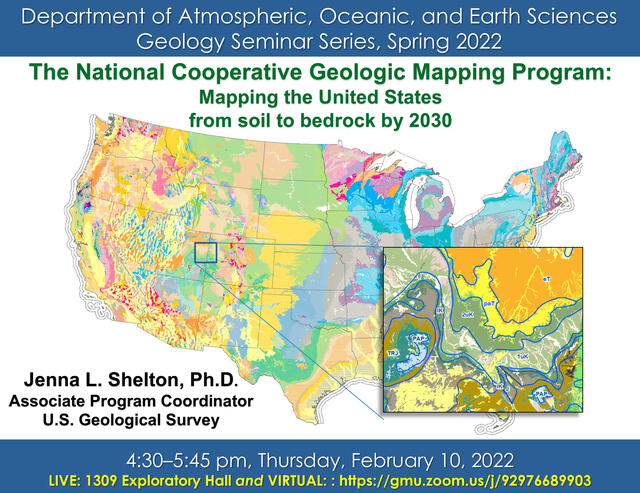
10 Feb (CLIM) Lickley, Climate Science Impacts
Megan Lickley, MIT Thu, 10 Feb, 9:00-10:00, via zoom (contact bklinger@gmu.edu for link)
Climate science targeting impacts and policy
Uncertainty in climate change complicates decision-making and undermines optimal policy choices. In this talk I will discuss insights from applying data science methods to Earth system models and observations in order to reduce such uncertainty and ultimately better inform policy choices. In particular, I focus on
1) Characterizing climate impacts and informing adaptation responses, by assessing the evolution of climate metrics that are key to human populations including water resources, the duration of rapid warming and sea level change, and modeling dynamic human responses to these transient processes.
2) Targeting climate science at mitigation policy, by evaluating global compliance with the Montreal Protocol, the only binding UN treaty ratified by all member states to regulate greenhouse gas production.
11 Feb (CLIM) Klinger, Current Climate Conversation
Fri, 11 Feb, 12:00-1:00, via zoom (contact bklinger@gmu.edu for link)
Quasi-monthly AOES discussion of notable recent climate and weather events. Come with an interesting news item. Come to add your two cents. Or just come to listen.
16 Feb (CLIM) DelSole, Model Tuning
Tim DelSole, AOES
Model Tuning
Wed, 16 Feb, 1:30-2:30, Johnson Center Meeting Room G and via Zoom (contact bklinger@gmu.edu for link)
17 Feb (GEOL) Park, Theoretical seismology and crustal structure
Jeffrey Park, Yale University: Theoretical seismology and crustal structure
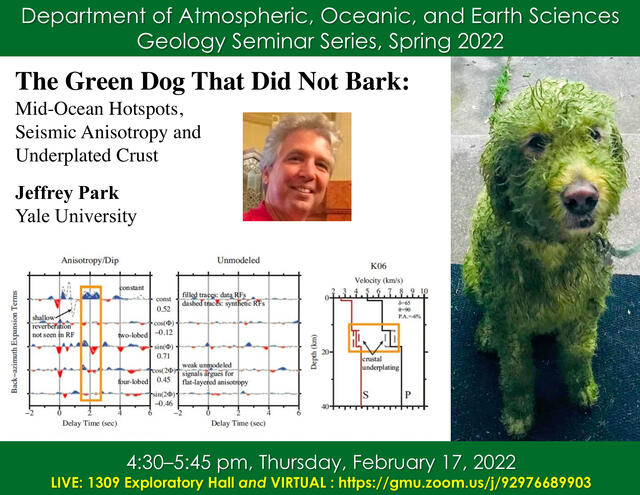
24 Feb (GEOL) Kodama, Paleomagnetism and Rock Magnetism

Ken Kodama, Lehigh University: Paleomagnetism and Rock Magnetism
4:30pm-5:45pm at 1309 Exploratory Hall
2 Mar (CLIM) Acosta, Paleogeography and Monsoons
Paul Acosta, AOES
Wed, 2 Mar, 1:30-2:30, via zoom (contact bklinger@gmu.edu for link)
Role of tectonic and paleogeography on monsoon systems
3 Mar (GEOL) Yang, Permian of China
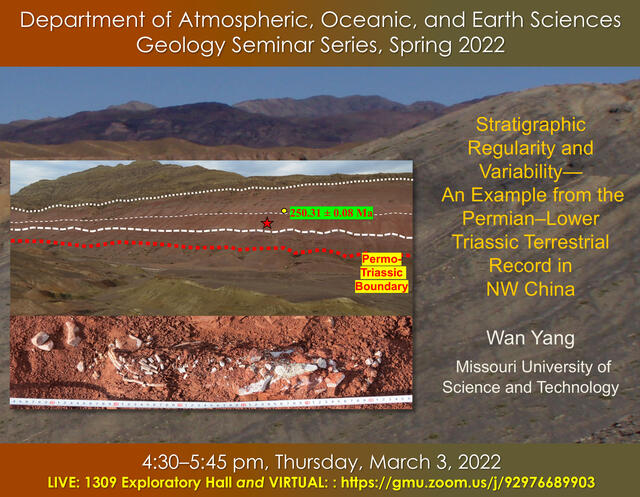
Wan Yang, Missouri University of Science and Technology: Permian of China
4:30pm-5:45pm at 1309 Exploratory Hall
9 Mar (CLIM) Breen, Deep Learning for AGCMs
Kathy Breen, NASA Goddard Space Flight Center
Wed, 9 Mar, 1:30-2:30, Johnson Center Meeting Room G & via zoom
Physics-constrained deep learning parameterizations for AGCMs
In this seminar, I will discuss my recent work at NASA in physics-based and AI hybrid modeling applications wrt cloud microphysics and aerosol-cloud interactions. The objectives of this work are to 1) develop surrogate AI models for computationally expensive modules in AGCMS that parameterize the contribution of clouds and aerosols to net radiative balance and 2) use probabilistic modeling frameworks to assimilate sub-grid scale physics.
10 Mar (GEOL) Pfeifer, Loess in Eastern Pangea
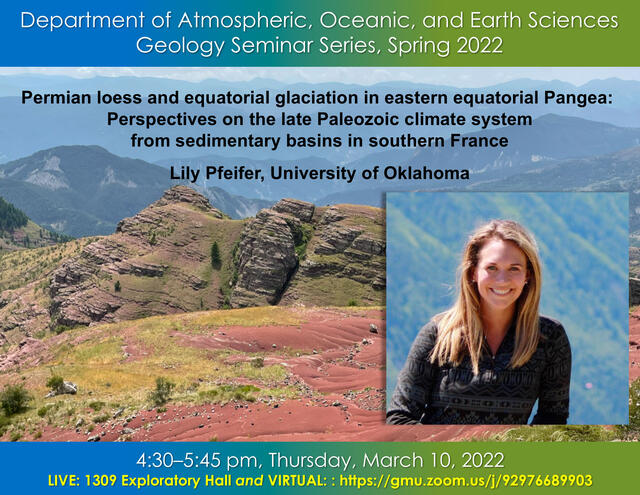
Lily Pfeifer, University of Oklahoma: Loess in Eastern Pangea
4:30pm-5:45pm at 1309 Exploratory Hall
11 Mar (CLIM) Klinger, Current Climate Conversation
Fri, 11 Mar, 12:00-1:00, location TBA
Quasi-monthly AOES discussion of notable recent climate and weather events. Come with an interesting news item. Come to add your two cents. Or just come to listen.
23 Mar (CLIM) Huang, MJO-QBO in CESM2
Kai Huang, AOES
Wed, 23 Mar, 1:30-2:30, Johnson Center Meeting Room G
MJO-QBO connection in the CESM2 prediction system.
24 Mar (GEOL) Brown, Metamorphism and Global Tectonics
Michael Brown, University of Maryland, Metamorphism and Global Tectonics
4:30pm-5:45pm at 1309 Exploratory Hall
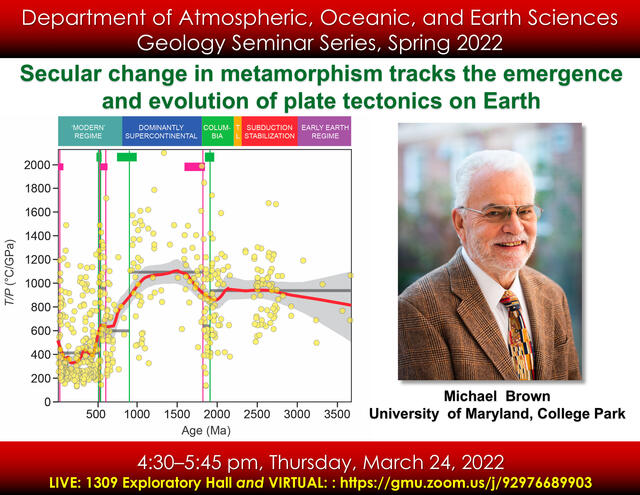
30 Mar (CLIM) Pegion, Predictability SE US Precipitation
Kathy Pegion, AOES
Wed, 30 Mar, 1:30-2:30, via zoom (contact bklinger@gmu.edu for link)
Understanding Predictability of Daily Southeast US Precipitation using Explainable Machine Learning
We investigate the predictability of the sign of daily South-East US (SEUS) precipitation anomalies associated with large-scale climate variability where the predictors are perfectly known using machine learning models. Indices of climate phenomena (e.g., NAO, AMO, PDO, ENSO, MJO, etc.) produce neither accurate nor reliable predictions, indicating that the indices themselves are not good predictors. A convolutional neural network using gridded fields as predictors is reliable and more accurate than the index-based models. Using explainable machine learning we identify which variables and gridpoints of the input fields are most relevant for confident and correct predictions. Our results show that the local circulation is most important as represented by the maximum relevance of 850hPa geopotential heights and zonal winds to making skillful, high probability predictions. Corresponding composite anomalies identify connections with the El-Nino Southern Oscillation during winter and the Atlantic Multidecadal Oscillation and North American Subtropical High during summer.
31 Mar (GEOL) Soreghan, Paleo-landscapes of Late Paleozoic
Lynn Soreghan, University of Oklahoma: Paleo-landscapes of Late Paleozoic
4:30pm-5:45pm at 1309 Exploratory Hall

6 Apr (CLIM) Larson, Ocean in Extratropical Climate
Sarah Larson, North Carolina State U
Coupled model experiments to better understand the ocean’s role in extra-tropical climate variability now and in the future
Wed, 6 Apr, 1:30-2:30, via zoom (contact bklinger@gmu.edu for link)
Identifying the relative importance of El Niño - Southern Oscillation (ENSO), wind-driven ocean dynamics, and air-sea heat fluxes in driving climate variability is crucial to understanding climate impacts and predictability. First, this presentation will highlight the ocean’s role in modifying the sea surface temperature (SST) response and North American precipitation pattern associated with variability of the Aleutian low. Our coupled model shows that the tropical ocean, through forcing associated with ENSO, can destructively interfere with the SST and precipitation patterns associated with the Aleutian low. Second, this presentation will show how the relationship between air-sea heat fluxes and wind-driven ocean dynamics in driving SST variability may change in a future climate. Analyses of CMIP6 future climate simulations suggest that as the Hadley cell expands poleward, the role of wind-driven ocean dynamics in the subtropical oceans may significantly change.
7 Apr (GEOL) Hansell, Documenting After Coal
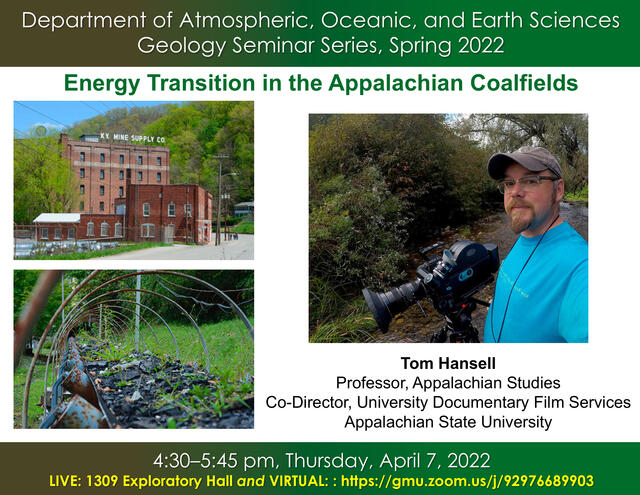
Tom Hansell, Appalachian State University: Documenting After Coal
4:30pm-5:45pm at 1309 Exploratory Hall
8 Apr (CLIM) Klinger, Current Climate Conversation
Fri, 8 Apr, 1:30pm-2:30pm, (contact bklinger@gmu.edu for link)
Quasi-monthly AOES discussion of notable recent climate and weather events. Come with an interesting news item. Come to add your two cents. Or just come to listen.
13 Apr (CLIM) Siler, Precipitation Isotope Ratios
Nick Siler, Oregon State U
A unified framework for interpreting variability in precipitation isotope ratios
Wed, 13 Apr, 1:30-2:30, via zoom (contact bklinger@gmu.edu for link)
Here we argue that the variability of precipitation isotope ratios can be understood from a new perspective, which is based on the idea that atmospheric vapor transport is attenuated by precipitation in much the same way that radiation is attenuated by scattering or absorption. We use the mathematical framework of radiative transfer to estimate the spatial pattern of δ18O in precipitation (δp) given only the monthly-mean patterns of evaporation, precipitation, and column-integrated vapor transport (IVT). The model accurately simulates the spatial and seasonal patterns of δp variability both in the observational record and in a historical GCM simulation. At high latitudes, δp variability is mostly driven by evaporation, which is highly sensitive to temperature. In contrast, low latitudes are dominated by the transport length scale, which is inversely proportional to precipitation. This result suggests that the temperature and amount effects are not the result of distinct mechanisms, but can be explained by a single principle of hydrologic attenuation applied to different patterns of precipitation, evaporation, and IVT.
14 Apr (GEOL) Smith, Paleobotany and Plant Evolution

Selena Smith, University of Michigan: Paleobotany and Plant Evolution
4:30pm-5:45pm at 1309 Exploratory Hall
20 Apr (CLIM) Durran, Deep Learning Sub-Seasonal Forecasting
Dale Durran, U. Washington
Can Deep Learning Weather Prediction Bring Rain to the Sub-Seasonal Forecasting Desert?
Wed, 20 Apr, 1:30-2:30, via Zoom (contact bklinger@gmu.edu for link)
Sub-seasonal weather forecasts, at lead times of 2-6 weeks for weekly averages, are the least skillful forecasts currently being attempted. Improved forecasts are needed for agricultural planning, energy and water supply management, and preparation for weather related disasters and diseases.
Subseasonal prediction relies on an ensemble of Numerical Weather Prediction (NWP) forecasts reflecting our uncertainty about the initial state of the atmosphere and other factors. Even using the most powerful computers, NWP requires too much computational time to generate ensembles with more than 50 members.
We recently developed deep-learning-based models that approach the accuracy of NWP. The deep-learning approach is orders of magnitude faster, allowing the use of much larger ensembles. Of equal significance, deep learning weather prediction incorporates the influence of unresolved physical processes without the development of explicit parameterizations. Conditions at the earth’s surface exert important influence on sub-seasonal and seasonal weather anomalies, and the model has shown skill at forecasting 2-m temperatures without any boundary layer parameterization.
21 Apr (GEOL) Racicot, Marine Mammal Sensory System Evolution
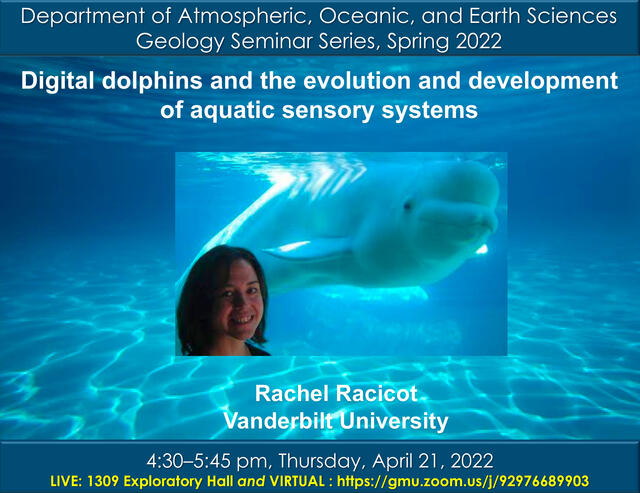
Rachel Racicot, Vanderbilt University: Marine Mammal Sensory System Evolution
4:30pm-5:45pm at 1309 Exploratory Hall
22 Apr (CLIM) ESOM Graduate Symposium
Graduate Students, Various Institutions
Earth System Observations & Modeling Graduate Symposium
Fri, 22nd Apr, All Day Symposium on Earth Day,
Returning for its third year, the ESOM Graduate Symposium encourages earth science graduate students to share their research focused on observational and modeling topics related to our climate. Event will include multiple sessions: 15-minute presentations, poster sessions, two keynote speaker presentations, and a career panel for masters and doctoral students.
We are also pleased to host Dr. Syukuro Manabe, Nobel Prize Laureate, for a Q&A session.
27 Apr (CLIM) Jnglin Wills, Tropical Pacific Climate Change
Robert Jnglin Wills, U Washington
Historical and future climate change in the tropical Pacific: Forced and unforced components
Wed, 27 Apr, 1:30-2:30, via zoom (contact bklinger@gmu.edu for link)
Historical trends show intensified warming in the western equatorial Pacific, relatively little warming in the eastern equatorial Pacific, and a strengthening of the Walker Circulation. In contrast, coupled climate models display a weakening of the Walker circulation and enhanced warming in the eastern equatorial Pacific in response to greenhouse gas forcing. The difference between observed and modeled trends is a leading source of uncertainty in future climate projections, because Walker circulation changes have cascading impacts on regional rainfall and temperature patterns, stratocumulus cloud cover, and global temperature. I will present novel statistical analyses that suggest this discrepancy between observations and models is not simply an anomalous phase of internal decadal variability (i.e., of the Pacific Decadal Oscillation), but rather, that climate models are unable to reproduce the spatial pattern of observed secular trends over the period 1979–present. I will discuss ongoing work to understand the processes contributing to the anomalous observed trends.
28 Apr (GEOL) Student Presentations
4 May (CLIM) Nobre, Amazon Tipping Point
Carlos Nobre, U Sao Paolo
Wed, 4 May, 1:30-2:30, via zoom (contact bklinger@gmu.edu for link)
The Amazon near a Tipping Point: the urgent need of a new standing forest bioeconomy.
The Amazon is very close to a tipping point of “savannization” caused by global warming and deforestation. Reducing the risk requires zero forest degradation in southern Amazon immediately and in all of the Amazon before 2030. Additionally, restoration of more than 200,000 km2 of forest is necessary to avoid the risk of a tipping point. It is urgently necessary to create a new bioeconomy of standing forest and flowing rivers, based on the immense potential richness of rainforest products and combining nature-based science and technological innovations with traditional knowledge of Indigenous Peoples and local communities. This is the key idea of the Amazon 4.0 project, which seeks to demonstrate the feasibility of this new bioeconomy through bioindustrialization in rural and urban communities in the Amazon.
5 May (CLIM) Gozdz, PhD Defense, Atlantic SST Variability
Olivia Gozdz, Climate Dynamics Doctoral Program
The Impact of Ocean Dynamics on Atlantic Sea Surface Temperature Variability
Thu, 5 May, 2:00-3:00, Johnson Center Meeting Room G [note new room] and via zoom (contact bklinger@gmu.edu for link)
Dissertation Director: Dr. Martha Buckley, Co-Advisor: Dr. Timothy DelSole
Internal variations of Atlantic sea surface temperature (SST) on decadal to multidecadal timescales have been linked to numerous climate phenomena with subsequent socioeconomic impacts, such as frequency and intensity of Atlantic hurricanes, droughts in Sahel and Arctic sea ice extent. Therefore, understanding the mechanisms of Atlantic SST variability is crucial to producing reliable predictions of these phenomena. Unfortunately, a consensus on the mechanisms of Atlantic SST variability has not been achieved, and as a result there has been intense debate about the relative roles of external forcing, stochastic atmospheric variability, and ocean dynamics in the Atlantic Multidecadal Variability (AMV). The goal of this dissertation is to improve our understanding of the relative roles of ocean dynamics and atmospheric forcing in internally generated Atlantic SST variability.
To accomplish this goal, we compare a fully coupled atmosphere-ocean-ice model to a model in which the ocean is replaced by a motionless slab layer (henceforth slab ocean model). Differences in variability between the two models are diagnosed by an optimization technique that finds components whose variance differs as much as possible between the two models. A major result is that suppressing interactive ocean circulations produces significant differences in variability between the two models. In particular, suppressing ocean circulations enhances variability associated with the AMV and the tripole SST, suggesting that ocean dynamics tend to damp large-scale modes. On the other hand, variability associated with the Atlantic Nin ̃o and subpolar gyre are suppressed, which is not surprising since ocean circulations are known to play a significant role in these modes. Contrary to initial expectations, the Atlantic Meridional Overturning Circulation has no significant influence on Atlantic SST variability in the fully coupled model.
Suppressing ocean circulations impacts atmospheric sea level pressure (SLP) primarily through two modes. The two leading modes are associated with SST patterns similar to the leading SST differences, suggesting that internally forced component of the SLP differences arise primarily as the response to the SST differences. One of these modes is associated with the Atlantic Nin ̃o, as one would expect from suppressing ocean dynamics.
The differences found here defy simple explanation. For instance, the two models might have different memory time scales. However, significant differences were found even after regressing out SST at several lags. Alternatively, the fully coupled ocean might have more variability simply because it depends on more variables than the slab model. However, significant differences were found even after regressing out a host of variables that exist only in the fully coupled model (e.g., sea surface height).
The above results are based on analysis of a model hierarchy. An alternative approach based on observations is utilized to diagnose relations between SST and other variables that indicate ocean dynamics. One such diagnostic is a positive correlation between temperature and salinity. Evaluating this diagnostic in multiple observational and reanalysis products confirms the notion that the subpolar North Atlantic is a region with strong ocean- dynamical influence. On the other hand, this diagnostic suggests that the tropical Atlantic is dominated by atmospheric forcing and potentially a thermodynamic wind-evaporation-SST feedback. Although an Atlantic Nin ̃o exists in observations and requires ocean dynamics, it plays a relatively minor role in local regions.
5 May (GEOL) Student Presentations
6 May (CLIM) Klinger, Current Climate Conversation (cancelled)
Fri, 6 May, 1:30pm-2:30pm - This seminar has been cancelled.
Quasi-monthly AOES discussion of notable recent climate and weather events. Come with an interesting news item. Come to add your two cents. Or just come to listen.
11 May (CLIM) Bach, Earth system prediction
Eviatar Bach, U Maryland
Towards the combination of physical and data-driven forecasts for Earth system prediction
Wed, 11 May, via Zoom (contact bklinger@gmu.edu for link)
There is great interest in applying machine learning (ML) to Earth system prediction. In this talk I will discuss hybrid methods which combine ML, physical models, and observations. I will present two such hybrid methods: Ensemble Oscillation Correction (EnOC) and multi-model data assimilation (MM-DA). EnOC leverages oscillatory modes in the climate in order to improve forecasts, and I will show its application to improve South Asian monsoon prediction. A more general method for combining multiple models and observations is MM-DA. I will discuss the new multi-model ensemble Kalman filter, its use for DA and forecasting, and future work.
16 May (CLIM) Benson, PhD Defense, Heatwave Prediction
David Benson, Climate Dynamics Doctoral Program
The role of land-atmosphere interactions in the improvement of heatwave prediction
Mon, 16 May, 11:00-12:00, Johnson Center Meeting Room D [note new room] and via Zoom (contact bklinger@gmu.edu)
Dissertation Director: Paul Dirmeyer
Increased heatwave frequency across the United States has led to the need for improved predictability of heatwave events. A detailed understanding of land-atmosphere interactions and the relationship between soil moisture and temperature extremes could provide useful information for prediction. This study identifies, for many locations, a threshold of soil moisture below which there is an increase in the sensitivity of atmospheric temperature to declining soil moisture. This shift to a hypersensitive regime causes the atmosphere to be more susceptible to atmospherically driven heatwave conditions. The soil moisture breakpoint where the regime shift occurs is estimated using segmented regression applied to observations and reanalysis data. It is shown that as the soil gets drier, there is a concomitant change in the rate of decrease in latent heat flux and increase in sensible heat flux leading to a strong positive feedback of increased air temperature near the surface, which further dries out the soil. Central, southwestern, and southeastern parts of the US seem to have regions of clear regime shifts, while the eastern part of the US generally does not get dry enough to reveal significant breakpoints. Sensible heat flux is seen to be a primary driver of this increased temperature
Fall 2021 AOES Seminars
25 Aug (CLIM) Kinter, The New IPCC Climate Report
Jim Kinter, AOES & COLA
The New IPCC Climate Report: The Reality, the Inevitable, and Hope for the Future
Wed., 1:30pm, via Zoom [see below]
Global warming due to human use of fossil fuel is now undeniable, as affirmed in the latest Assessment Report from the Intergovernmental Panel on Climate Change (IPCC). Virginians are not exempt from the ongoing changes – there will be a new normal, and we all need to prepare for it. Knowing where, when, and by how much our accustomed climate will change is critically important to plan for the coming decades. This seminar will explain why and how climate is changing, the impacts on our Commonwealth and the world, and possible responses. People alive today may include the last generation that can take action to avoid the most dire consequences – it’s time to learn more about the climate crisis and what we can do about it.
To join webinar on Zoom, register in advance online. After registering, you will receive a confirmation email containing information about joining the meeting.
1 Sep (CLIM) Trenary, Sub-seasonal prediction
Laurie Trenary, AOES
Improving skill of empirical sub-seasonal prediction with CMIP6 data
Wed, 1 Sep, 1:30, via zoom [contact bklinger@gmu.edu for link]
2 Sep (GEOL) Remirez, Biogeochemistry
Mariano Remirez, George Mason University - Biogeochemistry
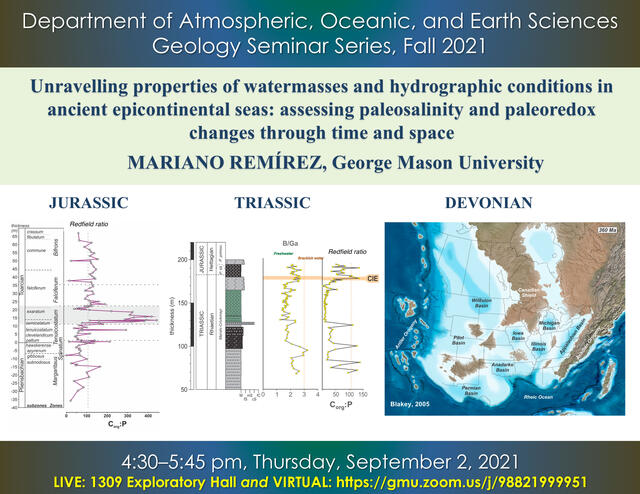
Thursday, 4:30-5:45 pm
1309 Exploratory Hall
9 Sep (GEOL) Ochoa, Humbolt Current Evolution
Diana Ochoa, University of Peru - Humbolt Current Evolution
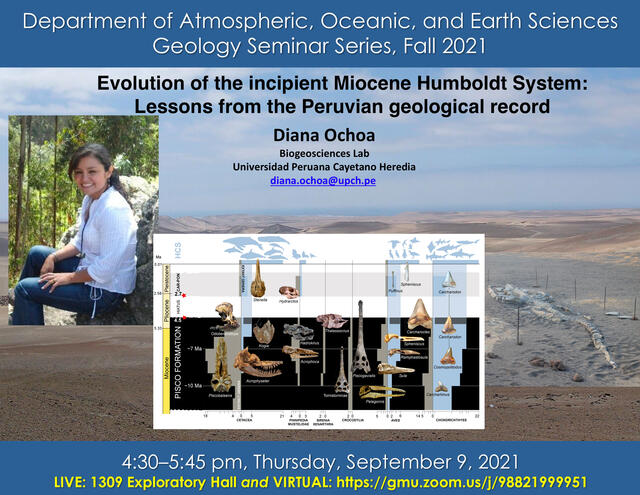
Thursday, 4:30-5:45 pm
1309 Exploratory Hall
10 Sep (CLIM) Current Climate Conversation
Fri, 10 Sep, 2pm, via zoom [contact bklinger@gmu.edu for link]
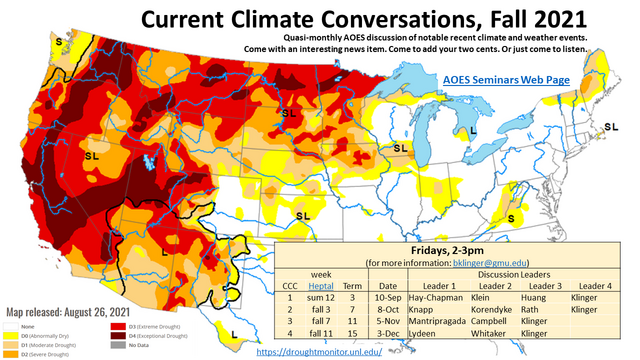
Quasi-monthly AOES discussion of notable reccent climate and weather events. Come with an interesting news item. Come to add your two cents. Or just come to listen.
15 Sep (CLIM) Abdolghafoorian, Land-Atmosphere Coupling Type
Abedeh Abdolghafoorian, AOES
Detecting the terrestrial Land-Atmosphere coupling type using information-theoretic metrics
Wed., 15 Sep, 1:30 pm
JC Room G
Land states affect the atmosphere through their control of surface turbulent fluxes, and the subsequent impact of those fluxes on boundary layer properties. I employ information-theoretic (IT) metrics to scrupulously study the strength and type of coupling between surface soil moisture and land surface heat fluxes. IT metrics are non-parametric and therefore attractive for the analysis of highly complex Earth systems with nonlinear cause-and-effect interactions among variables that may have non-normal distributions.
16 Sept (GEOL) Elrick, Paleo-Seawater Redox Trends
Maya Elrick, University of New Mexico
Paleo-Seawater Redox Trends
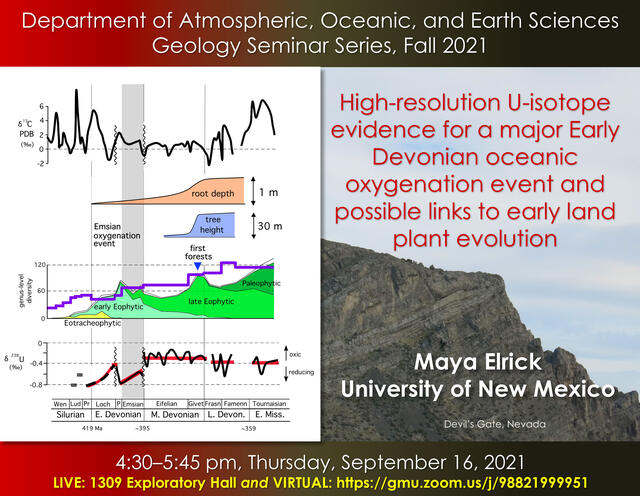
16 Sep (COS Galileo’s Science Cafe), Wilhelm-Miralles, Water Scarcity
Fernando Wilhelm-Miralles, AOES
Human demand vs climate change: which dominates the water scarcity problem around the world?
Thu, 16 Sep, 7pm – for details see Galileo’s Science Cafe
Changes to socioeconomics and an evolving climate system are likely to play a vital role in how regions around the world use water into the future. Water projections for the future, while prolific, remain highly variable and dependent upon underlying scenario and model assumptions. This investigation explores the interactions between population, economic growth, energy, land, water, and climate systems and how they interact dynamically within a consistent economic modeling framework, to address how changing socioeconomic and climate conditions alter global water futures.
22 Sep (CLIM) Straus, Particle-Wave Duality: Indian Monsoon
David Straus, AOES
The Particle-Wave Duality in Climate: An application to the Indian Monsoon Active-Break Cycle
Wed., 22 Sep, 1:30pm, via zoom [contact bklinger@gmu.edu for link]
23 Sep (GEOL) Schroeder, Antarctic Radio-Glaciology
Dusty Schroeder, Stanford University - Antarctic Radio-Glaciology
Thursday, 4:30-5:45 pm
1309 Exploratory Hall
27 Sep (GMU Vision Series), Shukla, Climate Change
Jagadish Shukla, AOES
Climate Change: Science, Politics and Ethics
Mon, 27 Sep, 7:00-8:15 – for details see Mason Vision Series
Climate change is one of the most challenging issues facing the world today. Climate science has firmly established that human burning of fossil fuels is the dominant cause of climate change. Therefore, with advances in science and technology, humans can reduce the harmful effects of climate change. However, adaptation to and mitigation of the impacts of global warming demands a concerted effort by governments, corporations, institutions, and individuals. In his presentation, Dr. Jagadish Shukla will focus on the physical science of climate change, while emphasizing that to truly address this issue, one also must understand the many social, economic, ethical, political, and social justice challenges it presents. He will conclude by explaining that even though time is running out, there are reasons to be hopeful about climate solutions. if we act decisively and dramatically to achieve net zero emissions by mid-century, we still have a chance to avoid climate change’s most catastrophic impacts.
29 Sep (CLIM) Wenegrat, The Gulf Stream
Jacob Wenegrat, U. Maryland
The Gulf Stream – barrier, blender, or... breadmaker? Enhanced mixing at sharp ocean fronts?
Wed, 29 Sep, 1:30pm
Johnson Center Mtg Room D AND via zoom (contact bklinger@gmu.edu for link)
The Gulf Stream front separates the North Atlantic subtropical and subpolar gyres, which have very distinct physical, biological, and chemical properties. How much exchange occurs across the front, and what causes it, is a long-standing question in physical oceanography. Here I will discuss unique direct observations of mixing across the Gulf Stream north wall, which, along with high-resolution numerical models, show how instabilities of sharp fronts enhance mixing between the ocean gyres. This submesoscale (horizontal scales of 0.1-10 km) source of mixing may play a significant role in the freshwater and nutrient budgets of the subtropics, but will not be directly resolved in climate models for many decades.
30 Sep (GEOL) Over, Structure from Motion
in-Si Over, Woods Hole - Structure From Motion
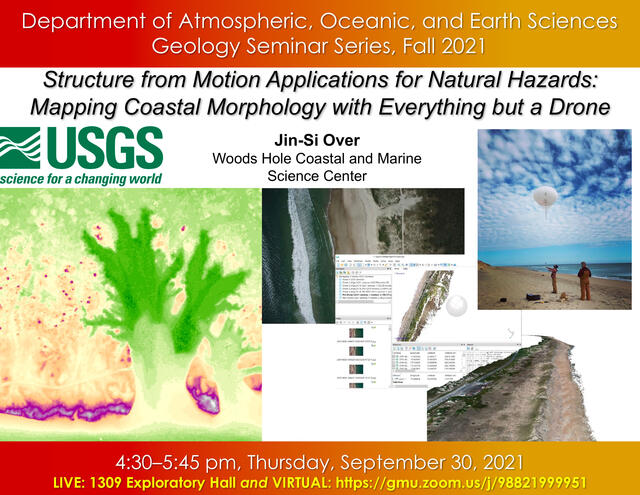
Thursday, 4:30-5:45 pm
1309 Exploratory Hall
6 Oct (CLIM) McMonigal, Rapid Indian Ocean Warming
Kay McMonigal, North Carolina State U
Why is the Indian Ocean warming so rapidly?
Wed., 6 Oct, 1:30pm, via Zoom [contact bklinger@gmu.edu for link]
Since 2000, the Indian Ocean has warmed more rapidly than the Atlantic or Pacific. Air sea fluxes cannot explain the observed warming, suggesting that the ocean must play a role. Previous studies have linked the warming to an increase in the amount of tropical water entering the Indian Ocean from the Pacific through the Indonesian Throughflow. We investigate the role that the heat transport across the southern boundary of the Indian Ocean at 36°S plays in the warming by combining observations from moorings across the Agulhas Current with ship-based and Argo hydrographic profiles across the interior.
7 Oct (GEOL) Perez-Angel, Paleoclimate and Tectonics
Lina Pérez-Angel, University of Colorado - Paleoclimate And Tectonics
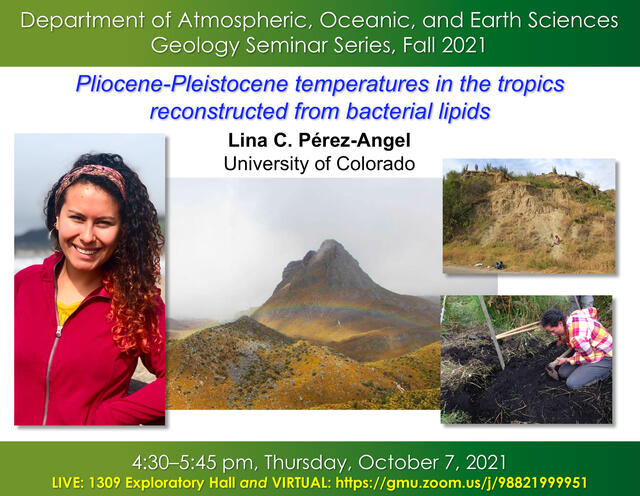
Thursday, 4:30-5:45 pm
1309 Exploratory Hall
8 Oct (CLIM) Current Climate Conversation
Fri, 8 Oct, 2pm, room-or-zoom TBA

Quasi-monthly AOES discussion of notable reccent climate and weather events. Come with an interesting news item. Come to add your two cents. Or just come to listen.
13 Oct (CLIM) Steucker, Regional Climate Change
Malte F. Stuecker, U Hawai’I at Manoa
A new general framework for understanding the drivers of regional climate change
Wed., 13 Oct, 1:30pm, via Zoom [contact bklinger@gmu.edu for link]
With the Earth warming in response to anthropogenic greenhouse gas forcing, changes in climate variables such as surface temperature and rainfall manifest themselves with characteristic geographical patterns. For instance, the poles warm faster than the low-latitudes and the tropics warm faster than the subtropics. I will present a new general framework that utilizes linear impulse response theory and idealized climate model simulations that allows us to delineate the different dynamical drivers of these regional climate change patterns.
14 Oct (GEOL) Felikson, Greenland Ice Dynamics
Denis Felikson, NASA - Greenland Ice Dynamics
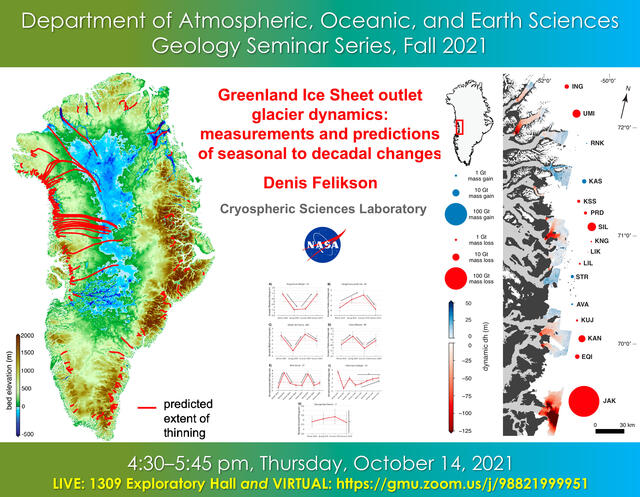
Thursday, 4:30-5:45 pm
1309 Exploratory Hall
15 Oct (AOES) Cash, Climate Models and Human Health
Benjamin Cash, AOES
Making new mistakes faster than ever: Supercomputers, climate models, and human health
Fri, 15 Oct, 12:30, via Zoom [contact bklinger@gmu.edu for link]
18 Oct (AOES) Buckley, Ocean Role in Climate
Martha Buckley, AOES
The role of the ocean in climate: moving beyond the Atlantic Multidecadal Variability
Mon, 18 Oct, 1pm via Zoom [contact bklinger@gmu.edu for link]
20 Oct (CLIM) Seo, Land-Atmosphere Influence on Model Bias
Eunkyo Seo, AOES
Investigation of land-atmosphere interaction in UFS and its influence on model mean bias
Wed, 20 Oct., 1:30
Johnson Center, Meeting Room D
The Unified Forecast System (UFS) is a fully coupled Earth modeling system. It will be the source system for NOAA‘s operational numerical weather prediction applications. The land surface process in the recent version of UFS is adopted by Noah-MP Land Surface Model (LSM) even though previous prototypes use Noah LSM. The main differences between these LSMs are a number of land tiles and snowpack layer and the existence of aquifer under bottom layer. This study investigates land-atmosphere interaction in UFS prototypes and its influence on model mean state bias, especially the impact of the LSM modification on the coupled model simulation.
21 Oct (GEOL) Hawley, Seismic Tomography and Hazards
William Hawley, Columbia University - Seismic Tomography and Hazards
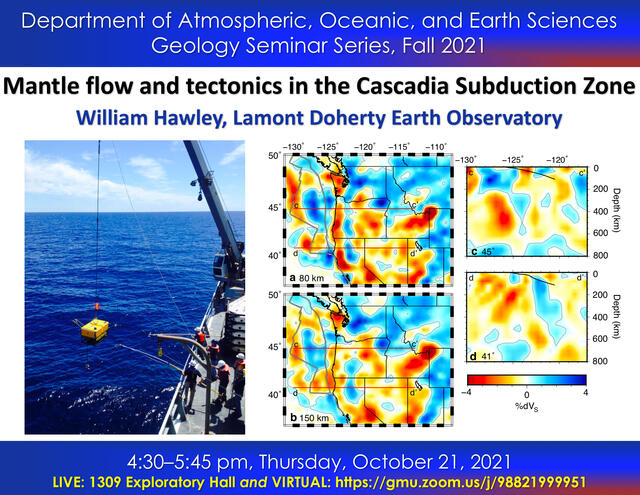
Thursday, 4:30-5:45 pm
1309 Exploratory Hall
27 Oct (AOES) Uhen, Cenozoic Marine Diversity
Mark Uhen, AOES
One Fish, Two Fish: A Brief History of Cenozoic Marine Vertebrate Diversity
Wed., 27 Oct., 1:30pm, via Zoom [contact bklinger@gmu.edu for link
28 Oct (GEOL) Greenwalt, Paleoentomology
Dale Greenwalt, Smithsonian - Paleoentomology
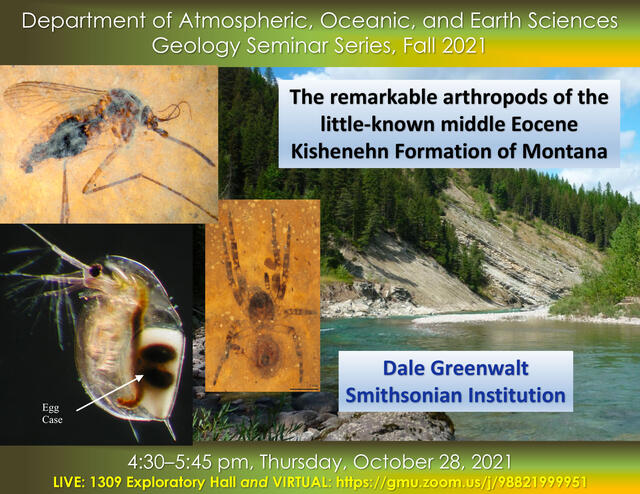
Thursday, 4:30-5:45 pm
1309 Exploratory Hall
3 Nov (CLIM) Li, Atmospheric Memory
Laifang Li, Pennsylvania State U.
Local atmospheric forcing on sea surface temperature variability: The role of atmospheric memory
Wed., 20 Oct, 1:30pm, via Zoom [contact bklinger@gmu.edu for link]
Variation of sea surface temperature (SST) results from a combination of atmospheric and oceanic forcing. The atmospheric forcing on SST is usually parameterized as white noise (WN) to reflect the relatively short memory of the atmosphere compared to the large heat inertia of the ocean mixed layer. In this study, we present evidence that the memory of atmospheric forcing has a substantial contribution to SST variability. In the extratropical North Pacific and North Atlantic, the Hasselmann model driven by WN atmospheric forcing underestimates the observed SST anomaly (SSTA) standard deviation (STD) by about 50%, whereas the model driven by an atmospheric forcing with observed memory produces a SSTA STD comparable to observations. Part of the extratropical atmospheric memory evidently originates from the tropical oceans, including the SSTA in the Niño3.4 region and the tropical North Atlantic.
4 Nov (GEOL) Wilson, Critical Minerals
Edith Newton Wilson, Rock Whisperer, LLC - Critical Minerals
Thursday, 4:30-5:45 pm
1309 Exploratory Hall
5 Nov (CLIM) Current Climate Conversation
Fri, 5 Nov, 2:30pm, via Zoom [note change in time]

Quasi-monthly AOES discussion of notable reccent climate and weather events. Come with an interesting news item. Come to add your two cents. Or just come to listen.
10 Nov (CLIM) Kumar, Water Cycle Modeling
Sujay Kumar, NASA GSFC
Progress toward the characterization and synthesis of water cycle with physical and data-driven modeling
Wed, 10 Nov, 1:30, Johnson Center Meeting Room D and via Zoom [contact bklinger@gmu.edu for link]
Freshwater is arguably the most precious resource in the world, sustaining ecosystems and human civilization. The task of quantifying the spatial and temporal variability of water cycle components is challenging due to the significant complexity and heterogeneity of these processes. Remote sensing observations are key to the spatially distributed characterization of these complex processes. Though NASA and other agency missions measure a myriad of variables related to Earth’s water cycle, their utilization within modeling and end-use environments is disconnected and fragmented from the perspective of freshwater quantification. In this talk, I will describe examples of leveraging and integrating assets in modeling, remote sensing, data assimilation, and machine learning to address challenging water availability issues, through open science tools and cloud-computing environments. In addition to describing the advances made towards the effective utilization of remote sensing data for hydrologic prediction, I will also discuss some of the challenges and gaps that remain.
11 Nov (GEOL) McBride, Coastal Processes in Australia
Randy McBride, George Mason University
Coastal Processes in Australia
Thursday, 4:30-5:45 pm
1309 Exploratory Hall
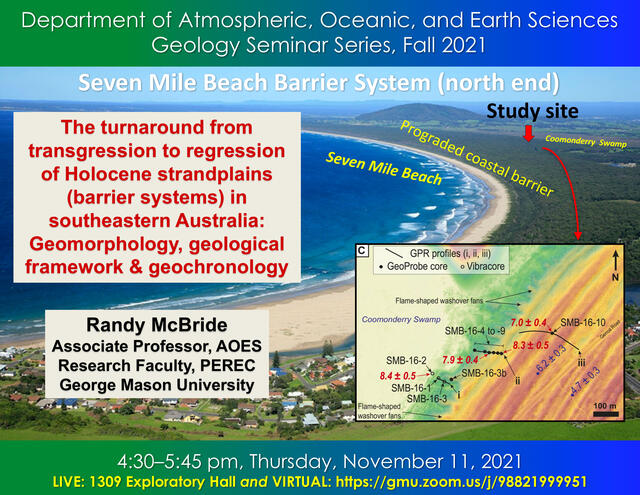
17 Nov (CLIM) Cronin, Dry Hurricanes
Timothy Cronin, MIT
Dry and Semi-dry Hurricanes
Wed., 1:30pm, via Zoom [contact bklinger@gmu.edu for link]
It is widely believed that tropical cyclones are an intrinsically moist phenomenon -- requiring evaporation and latent heat release. Recent numerical modeling, however, found formation in dry radiative-convective equilibrium (RCE) -- raising many questions. To address these questions, a convection-permitting model is used to simulate RCE. Tropical cyclones are found to spontaneously form and persist in both moist and dry/cold states, as well as part of the relatively moist/warm intermediate parameter space. As the surface is dried or cooled, cyclones weaken, and become more uniform in intensity. Structurally, dry and semi-dry cyclones have larger radii of maximum winds relative to their outer wind field, less variability in size, and prominent eyewall asymmetries. Simulations reveal that a range of parameter space is a barrier to spontaneous genesis but not cyclone existence.
18 Nov (GEOL) Smith, Eocene Green River Formation
Mike Smith, Northern Arizona University - Eocene Green River Formation
Thursday, 4:30-5:45 pm
1309 Exploratory Hall
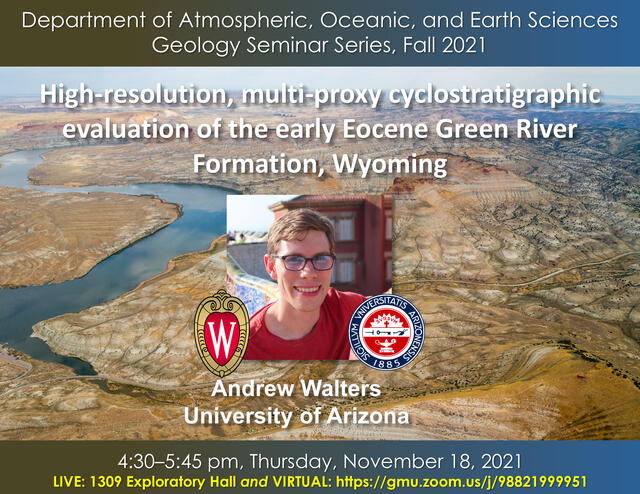
22 Nov (CLIM) Korendyke, Climate Science MS Thesis Defense
Mary Korendyke, Climate Science MS Thesis Defense
The modulation of atmospheric rivers by circulation regimes in the EMCWF coupled model: fidelity and resolution dependence.
Mon, 22 Nov, 3-4pm, Research Hall 121 (CLIM Lab) and via Zoom [contact bklinger@gmu.edu for link]
The large scale circulation of the atmosphere, as characterized by circulation regimes, have a significant influence on storminess and precipitation extremes. One type of structure known to be related to precipitation is atmospheric rivers, regions of intense poleward moisture flux. This raises the question of what spatial resolution is required to accurately simulate the circulation dependence of atmospheric rivers. This paper investigates the impact of enhanced resolution on the simulation of circulation regimes over the Pacific North American region during boreal winter, and the regime dependence of atmospheric river patterns. In particular we examine the realism of ensemble forecasts made with the ECMWF model at three different resolutions (100km, 31km, 16km). The regimes are determined from the k-means clustering method; our results focus on two choices for the number of clusters: 4 and 5. We create regime composites of z500 and u250 anomalies, then calculate spatial correlation, differences in regime persistence distribution, and annual maximum episode persistence to compare reanalysis with model simulations. Composites for regime-associated atmospheric rivers were also computed, and spatial correlations calculated. We find that regimes are better simulated in going from low to medium resolution, but that does not apply in going from the medium to high resolution. This discrepancy is possibly due to an error in the model’s vertical resolution. We find that generally regime persistence is well represented, with some exceptions. We also find that atmospheric rivers typically show good spatial correlation with their assigned regimes, and that the correlation is somewhat improved in going from the low to medium resolution despite a consistent undercounting of rivers in the model. Future work is needed to determine if the model loses moisture as the forecast length increases.
1 Dec (CLIM) Gorris, Climate and Valley Fever
Morgan Gorris, Los Alamos National Laboratory
Using climate and environmental data to understand Valley fever disease dynamics
Wed, 1 Dec, 1:30pm, via zoom [contact bklinger@gmu.edu for link]
Valley fever is a fungal disease primarily found throughout the southwestern United States, as well as parts of Central and South America. Humans can contract Valley fever by inhaling Coccidioides spp. fungal spores from the environment. Since Coccidioides grows in desert-like soils, the fungi are influenced by environmental conditions. Changes in the environment can influence the abundance and dispersal of Coccidioides, causing fluctuations in Valley fever incidence. I used Valley fever case data and environmental conditions to explore how climate controls the timing and number of Valley fever cases in the southwestern US, the current boundary of the endemic region for the disease, and what areas in the US may become endemic in response to future climate conditions. This work may be used to create effective mitigation strategies to reduce the health effects from Valley fever.
2 Dec (GEOL) Ramezani, High-Precision Geochronology
Jahan Ramezani, MIT - High-Precision Geochronology
Thursday, 4:30-5:45 pm
1309 Exploratory Hall
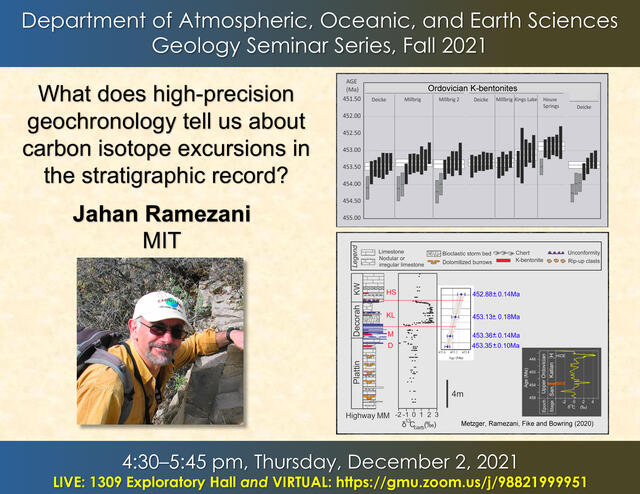
8 Dec (CLIM) Santos da Silva, Assessment Models for Climate
Silvia Regina Santos Da Silva, AOES
The contributions of Integrated Assessment Models (IAMs) to the climate science
Wed., 8 Dec, 1:30pm, Johnson Center Mtg Rm D and via Zoom [contact bklinger@gmu.edu for link]
There is wide recognition of the need of credible scenarios for guidance on developing climate research and policy. In this regard, integrated assessment models (IAMs) have been of utmost importance by producing socioeconomic and emissions scenarios that are the backbone of current climate change research. These models represent the most relevant interactions between human and Earth systems, allowing the examination of questions at the intersection of energy, water, land, socioeconomics, and climate not possible in single sector or single system models. In this talk, I will introduce IAMs and provide examples of their key contributions to research. Focus will be on a prominent model within the IAM community: Pacific Northwest National Laboratory’s Global Change Analysis Model (GCAM). Examples will illustrate how GCAM has helped us understand the future evolution of energy, water, land and climate systems under a wide range of conditions.
Climate Talks at Galileo Café & GMU Vision Series
AOES faculty speak about climate change in Mason lecture series outside of AOES.
16 Sep, COS Galileo Science Café: F. Wilhelm-Miralles.
27 Sep, Mason Vision Series: J. Shukla.
For more information, see the Seminar list below or click on these buttons:
